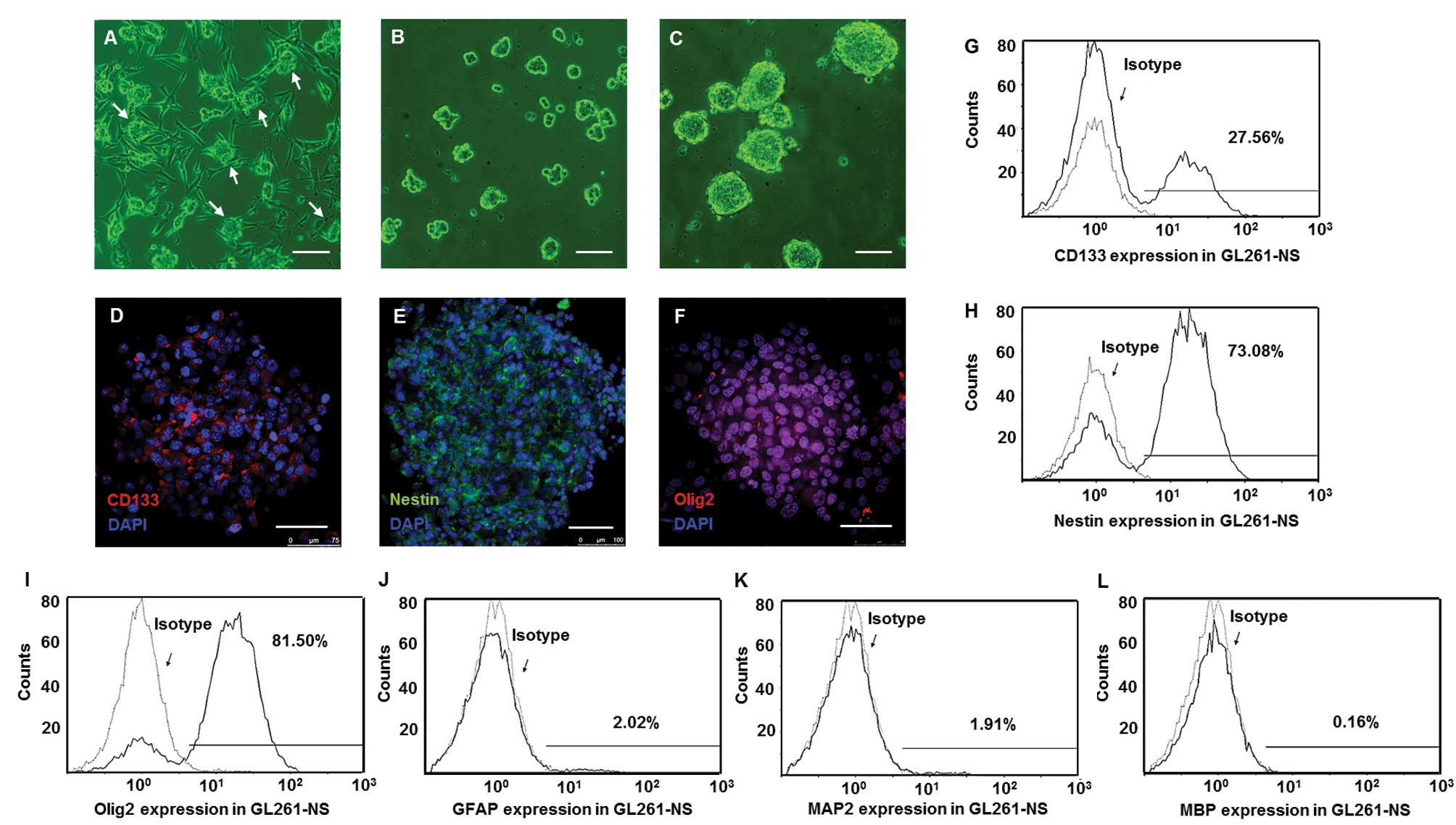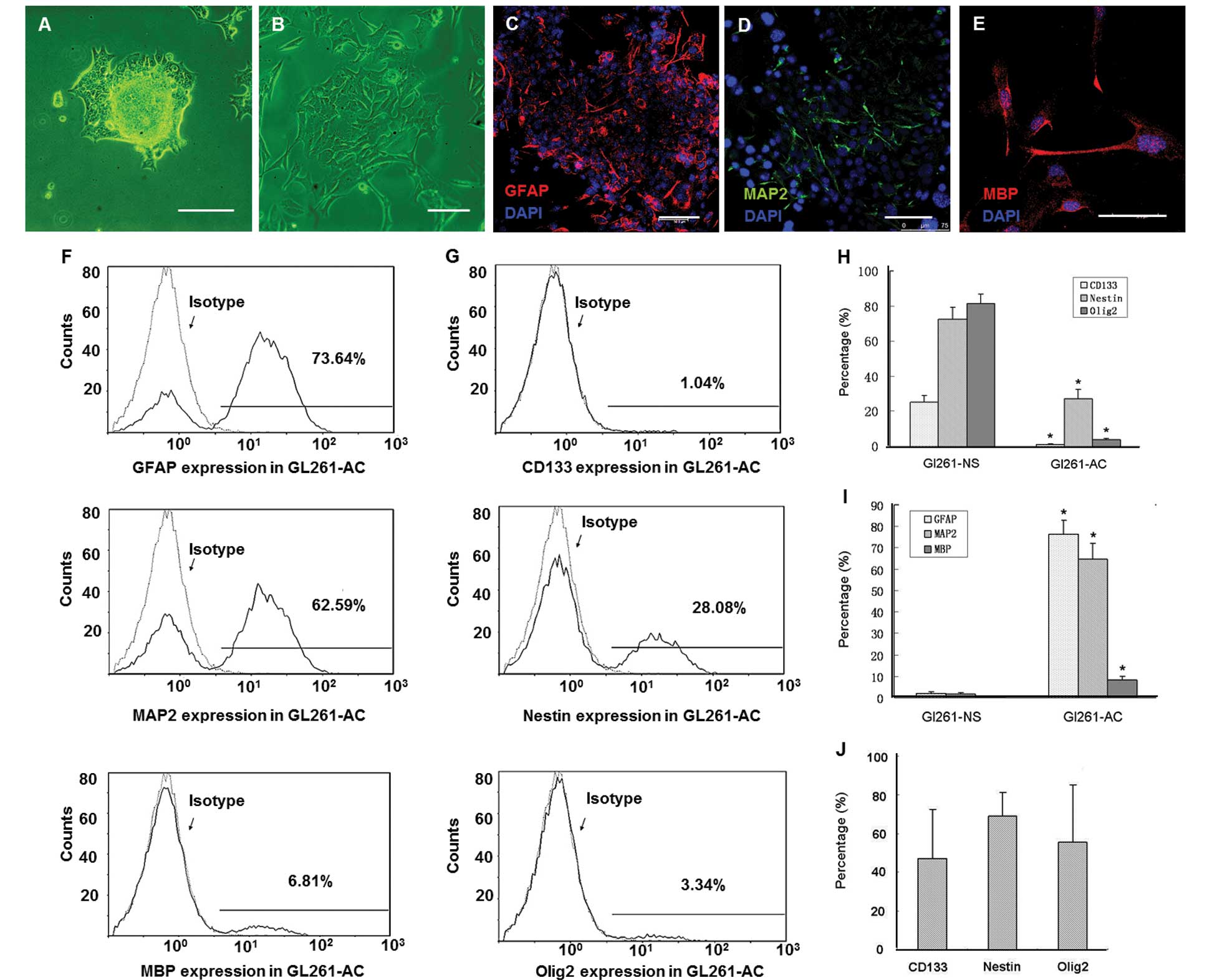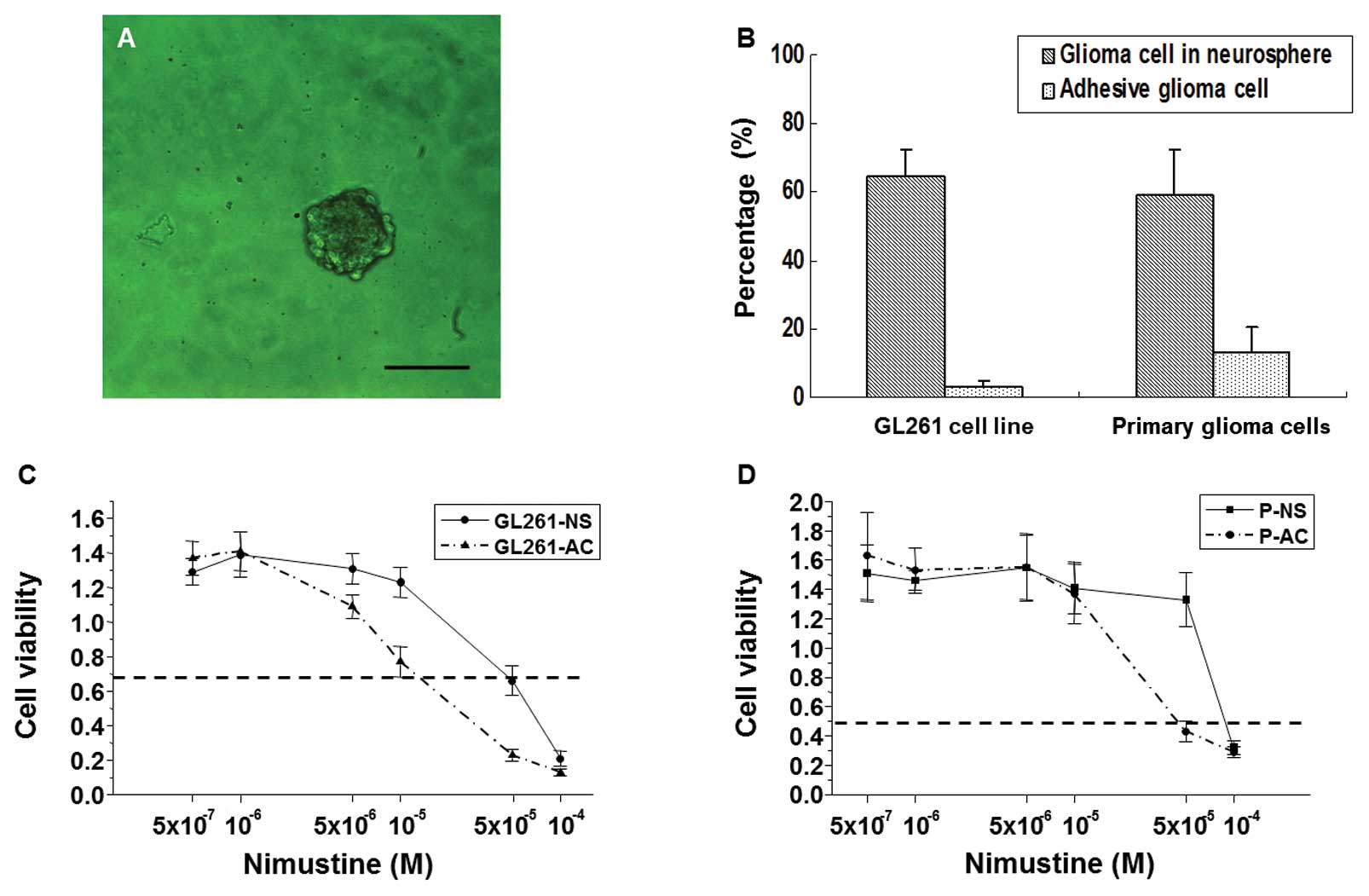|
1.
|
Stupp R, Hegi ME, Mason WP, et al: Effects
of radiotherapy with concomitant and adjuvant temozolomide versus
radiotherapy alone on survival in glioblastoma in a randomised
phase III study: 5-year analysis of the EORTC-NCIC trial. Lancet
Oncol. 10:459–466. 2009.
|
|
2.
|
Stiles CD and Rowitch DH: Glioma stem
cells: a midterm exam. Neuron. 58:832–846. 2008. View Article : Google Scholar : PubMed/NCBI
|
|
3.
|
Singh A and Settleman J: EMT, cancer stem
cells and drug resistance: an emerging axis of evil in the war on
cancer. Oncogene. 29:4741–4751. 2010. View Article : Google Scholar : PubMed/NCBI
|
|
4.
|
Sughrue ME, Yang I, Kane AJ, et al:
Immunological considerations of modern animal models of malignant
primary brain tumors. J Transl Med. 7:842009. View Article : Google Scholar : PubMed/NCBI
|
|
5.
|
Wei J, Barr J, Kong LY, et al:
Glioblastoma cancer-initiating cells inhibit T-cell proliferation
and effector responses by the signal transducers and activators of
transcription 3 pathway. Mol Cancer Ther. 9:67–78. 2010. View Article : Google Scholar : PubMed/NCBI
|
|
6.
|
Dziurzynski K, Wei J, Qiao W, et al:
Glioma-associated cytomegalovirus mediates subversion of the
monocyte lineage to a tumor propagating phenotype. Clin Cancer Res.
17:4642–4649. 2011. View Article : Google Scholar : PubMed/NCBI
|
|
7.
|
Pellegatta S, Poliani PL, Corno D, et al:
Neurospheres enriched in cancer stem-like cells are highly
effective in eliciting a dendritic cell-mediated immune response
against malignant gliomas. Cancer Res. 66:10247–10252. 2006.
View Article : Google Scholar : PubMed/NCBI
|
|
8.
|
Yu SC, Ping YF, Yi L, et al: Isolation and
characterization of cancer stem cells from a human glioblastoma
cell line U87. Cancer Lett. 265:124–134. 2008. View Article : Google Scholar : PubMed/NCBI
|
|
9.
|
Bao S, Wu Q, Sathornsumetee S, et al: Stem
cell-like glioma cells promote tumor angiogenesis through vascular
endothelial growth factor. Cancer Res. 66:7843–7848. 2006.
View Article : Google Scholar : PubMed/NCBI
|
|
10.
|
Maes W and Van Gool SW: Experimental
immunotherapy for malignant glioma: lessons from two decades of
research in the GL261 model. Cancer Immunol Immunother. 60:153–160.
2011. View Article : Google Scholar : PubMed/NCBI
|
|
11.
|
Yi L, Xiao H, Xu M, et al:
Glioma-initiating cells: a predominant role in
microglia/macrophages tropism to glioma. J Neuroimmunol. 232:75–82.
2011. View Article : Google Scholar : PubMed/NCBI
|
|
12.
|
Yi L, Zhou ZH, Ping YF, et al: Isolation
and characterization of stem cell-like precursor cells from primary
human anaplastic oligoastrocytoma. Mod Pathol. 20:1061–1068. 2007.
View Article : Google Scholar : PubMed/NCBI
|
|
13.
|
Yang S, Wang B, Guan C, et al:
Foxp3+IL-17+ T cells promote development of
cancer-initiating cells in colorectal cancer. J Leukoc Biol.
89:85–91. 2011.
|
|
14.
|
Beier D, Schulz JB and Beier CP:
Chemoresistance of glioblastoma cancer stem cells - much more
complex than expected. Mol Cancer. 10:1282011. View Article : Google Scholar : PubMed/NCBI
|
|
15.
|
Galli R, Binda E, Orfanelli U, et al:
Isolation and characterization of tumorigenic, stem-like neural
precursors from human glioblastoma. Cancer Res. 64:7011–7021. 2004.
View Article : Google Scholar : PubMed/NCBI
|
|
16.
|
Calabrese C, Poppleton H, Kocak M, et al:
A perivascular niche for brain tumor stem cells. Cancer Cell.
11:69–82. 2007. View Article : Google Scholar : PubMed/NCBI
|
|
17.
|
Krishnamurthy S, Dong Z, Vodopyanov D, et
al: Endothelial cell-initiated signaling promotes the survival and
self-renewal of cancer stem cells. Cancer Res. 70:9969–9978. 2010.
View Article : Google Scholar : PubMed/NCBI
|
|
18.
|
Li Z, Bao S, Wu Q, et al:
Hypoxia-inducible factors regulate tumorigenic capacity of glioma
stem cells. Cancer Cell. 15:501–513. 2009. View Article : Google Scholar : PubMed/NCBI
|
|
19.
|
Grivennikov SI, Greten FR and Karin M:
Immunity, inflammation, and cancer. Cell. 140:883–899. 2010.
View Article : Google Scholar
|
|
20.
|
Bayne LJ, Beatty GL, Jhala N, et al:
Tumor-derived granulocyte-macrophage colony-stimulating factor
regulates myeloid inflammation and T cell immunity in pancreatic
cancer. Cancer Cell. 21:822–835. 2012. View Article : Google Scholar
|
|
21.
|
Charles NA, Holland EC, Gilbertson R,
Glass R and Kettenmann H: The brain tumor microenvironment. Glia.
59:1169–1180. 2011. View Article : Google Scholar : PubMed/NCBI
|
|
22.
|
Hussain SF, Yang D, Suki D, Aldape K,
Grimm E and Heimberger AB: The role of human glioma-infiltrating
microglia/ macrophages in mediating antitumor immune responses.
Neurooncol. 8:261–279. 2006.PubMed/NCBI
|
|
23.
|
Wiencke JK, Accomando WP, Zheng S, et al:
Epigenetic biomarkers of T-cells in human glioma. Epigenetics.
7:1391–1402. 2012. View Article : Google Scholar : PubMed/NCBI
|
|
24.
|
Hong TM, Teng LJ, Shun CT, Peng MC and
Tsai JC: Induced interleukin-8 expression in gliomas by
tumor-associated macrophages. J Neurooncol. 93:289–301. 2009.
View Article : Google Scholar : PubMed/NCBI
|
|
25.
|
Guryanova OA, Wu QL, Cheng L, et al:
Non-receptor tyrosine kinase BMX maintains self-renewal and
tumorigenic potential of glioblastoma stem cells by activating
STAT3. Cancer Cell. 19:498–511. 2011. View Article : Google Scholar : PubMed/NCBI
|
|
26.
|
Lamszus K and Gunther HS: Glioma stem
cells as a target for treatment. Target Oncol. 5:211–215. 2010.
View Article : Google Scholar : PubMed/NCBI
|
|
27.
|
Chen J, McKay RM and Parada LF: Malignant
glioma: lessons from genomics, mouse models, and stem cells. Cell.
149:36–47. 2012. View Article : Google Scholar : PubMed/NCBI
|
|
28.
|
Li Z, Wang H, Eyler CE, Hjelmeland AB and
Rich JN: Turning cancer stem cells inside out: an exploration of
glioma stem cell signaling pathways. J Biol Chem. 284:16705–16709.
2009. View Article : Google Scholar : PubMed/NCBI
|
|
29.
|
Wagers AJ: The stem cell niche in
regenerative medicine. Cell Stem Cell. 10:362–369. 2012. View Article : Google Scholar : PubMed/NCBI
|
|
30.
|
Ginestier C, Liu S, Diebel ME, et al:
CXCR1 blockade selectively targets human breast cancer stem cells
in vitro and in xenografts. J Clin Invest. 120:485–497. 2010.
View Article : Google Scholar : PubMed/NCBI
|
|
31.
|
Sansone P, Storci G, Tavolari S, et al:
IL-6 triggers malignant features in mammospheres from human ductal
breast carcinoma and normal mammary gland. J Clin Invest.
117:3988–4002. 2007. View
Article : Google Scholar : PubMed/NCBI
|
|
32.
|
Weiss WA, Burns MJ, Hackett C, et al:
Genetic determinants of malignancy in a mouse model for
oligodendroglioma. Cancer Res. 63:1589–1595. 2003.PubMed/NCBI
|
|
33.
|
Hu X, Pandolfi PP, Li Y, Koutcher JA,
Rosenblum M and Holland EC: mTOR promotes survival and astrocytic
characteristics induced by Pten/AKT signaling in glioblastoma.
Neoplasia. 7:356–368. 2005. View Article : Google Scholar : PubMed/NCBI
|
|
34.
|
Szatmari T, Lumniczky K, Desaknai S, et
al: Detailed characterization of the mouse glioma 261 tumor model
for experimental glioblastoma therapy. Cancer Sci. 97:546–553.
2006. View Article : Google Scholar : PubMed/NCBI
|
|
35.
|
Hatiboglu MA, Wei J, Wu AS and Heimberger
AB: Immune therapeutic targeting of glioma cancer stem cells.
Target Oncol. 5:217–227. 2010. View Article : Google Scholar : PubMed/NCBI
|
|
36.
|
Wei J, Barr J, Kong LY, et al:
Glioma-associated cancer-initiating cells induce immunosuppression.
Clin Cancer Res. 16:461–473. 2010. View Article : Google Scholar : PubMed/NCBI
|
|
37.
|
Ausman JI, Shapiro WR and Rall DP: Studies
on the chemotherapy of experimental brain tumors: development of an
experimental model. Cancer Res. 30:2394–2400. 1970.PubMed/NCBI
|
|
38.
|
Daga A, Orengo AM, Gangemi RM, et al:
Glioma immuno-therapy by IL-21 gene-modified cells or by
recombinant IL-21 involves antibody responses. Int J Cancer.
121:1756–1763. 2007. View Article : Google Scholar : PubMed/NCBI
|
|
39.
|
Abdouh M, Facchino S, Chatoo W, Balasingam
V, Ferreira J and Bernier G: BMI1 sustains human glioblastoma
multiforme stem cell renewal. J Neurosci. 29:8884–8896. 2009.
View Article : Google Scholar : PubMed/NCBI
|
|
40.
|
Kim R, Emi M and Tanabe K: Cancer
immunoediting from immune surveillance to immune escape.
Immunology. 121:1–14. 2007. View Article : Google Scholar : PubMed/NCBI
|














